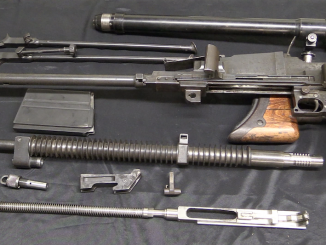The Japanese Navy used several different types of flare pistols during World War Two (and in the decades before), but the most impressive looking of the bunch was the three-barreled Type 90 (not to be confused with the two-barreled model also designated Type 90). The three barrels were not simply there to look intimidating, of course, but rather so that a flare of each of the three different colors in use could be kept ready at all times. The barrels were marked with colored decals to note the flare colors – one green, one white, and one red and yellow. In another unusual design decision, the entire upper assembly of the Type 90 is on a sliding spring-loaded track to absorb recoil.
For more information on Japanese flare pistols, see Teri’s page at Nambu World.



Flares were used to signal formation attacks by dive bombers if memory serves well. I watched a Japanese CG movie on YouTube made about the battle of the Santa Cruz Islands. Just before the Aichi D3A’s started their attack runs, the flight leaders fired flares to signal that targets were sighted. American attackers in contrast shouted radio code to indicate status. What seems weird is that both sides spotted each other by reconnaissance plane and then sent out strike forces at the same time, which meant the escort fighters of both formations were split between protecting friendly bombers and attacking enemy bombers. At least I didn’t see a duel between dive bombers, which would have been silly! Did I mess up?
Minoru Genda’s Pearl Harbor plan called for different attack patterns depending on American defensive response. One plan called for the torpedo bombers to go in first indicated by one flare, the other called for a more orderly attack — dive bombers first, followed by high-level bombers, and finally the torpedo bombers — signaled by two flares. When the attacker leader, Commander Mitsuo Fuchida, saw no US fighter opposition over Pearl Harbor, he decided the situation called for the more methodical option. Consequently, he fired two flares. However, the second flare fell into a cloud. Reasoning that his pilots may not have seen the second flare, he fired a third. As it turned out most of the attack force saw all three flares, which resulted in every section attacking more or less at will.
As the earlier comments suggest, anyone bidding on these, who wants to explain them to collection admirers, needs to know why they were common, and often used in Japanese aircraft during the war. Why wouldn’t the flight leader just radio verbal (if coded) instructions to everyone in the formation?
Because Japanese aviation radios were often only found in the lead a/c, were at least a generation behind Allied radios technologically, and remained at that tactical disadvantage for the whole war. These projectors are symbolic of one of several key handicaps the Imperial forces struggled with.